

Almost every outdoors enthusiast will find themself confused in a spotting scope vs. binoculars debate. Both of them serve similar functions but are mainly used with different goals in mind. They both allow you to see objects that are far away in great detail without getting close. For you to make the most out of either of the optic devices, you must have a complete understanding of each of them.
Binoculars are hand-held, portable, versatile optics that are made to be used by both eyes. The modern models have a plethora of features that can enhance your outdoor experience. Spotting scopes on the other hand, are tripod-mounted monocular scopes with high magnification. They are like a class above binoculars in terms of magnification. Read on for in-depth details on the features that set the two optical devices apart.
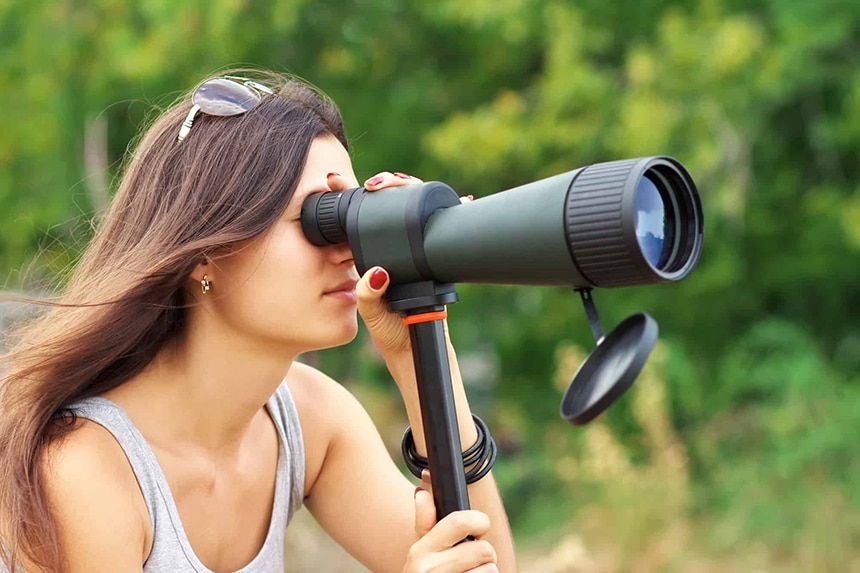
Spotting scopes are similar to portable telescopes. Though they aren’t as powerful as telescopes because they are meant for star gazing. They are excellent devices for outdoorsy people because of their outstanding magnification capability.
The scopes come in different sizes but mostly require being used with tripods. Some can be held in the hands for convenient use. A good tripod or stand just ensures you have a shake-free view. They are more cumbersome compared to other optical devices and are often pricey. Outdoor professionals looking for the best visual results never mind the hefty price tags.
Spotting scopes allow you to see subjects too far to see with your naked eye provided they are within the atmosphere. What’s more, spotters are more rugged than most optical devices. They are usually made weatherproof to survive the harsh outdoor elements.
Spotters are highly preferred for birding and nature watching. They allow users to watch animals from a distance without alerting them of their presence and scaring them away. Hunters also benefit from spotting scopes as they can spot and track their prey without the risk of losing their targets by changing positions.
Wildlife and nature photographers also use spotting scopes to take detailed close-up photos of animals that are far away. Some models are designed to work with cameras and they come in handy at photographing dangerous animals from a safe distance.
The Celestron Ultima 80 Straight Spotting Scope is one of the best spotting scopes for wildlife viewing according to most top reviewers. It is rich with features that make it perfect for long-distance viewing and observing nature.
Shooters, especially long-distance ones are also big users of spotting scopes. The spotters help them establish whether they have hit their target or not.
Another thing spotting scopes are good at is surveillance. When you need to watch someone or something from a distance without them knowing a spotting scope is the perfect tool for the job.
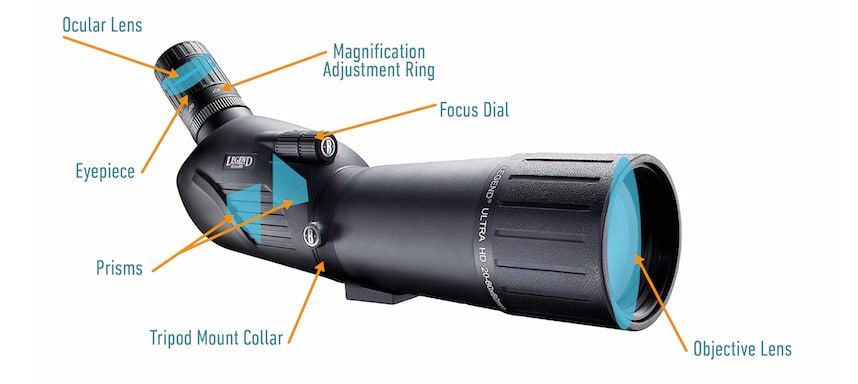
A Spotting scope offers a significantly higher magnification compared to other optical devices like Binoculars. Many models have a magnification between 20x and 60x. Anything less or more is unusual as more than 60x can lead to poorer image brightness.
Its optical assembly consists of an internal image erecting system, a removable eyepiece and a refracting objective lens. The image erecting system usually uses prisms (roof or Porro) or relay lenses.
The objective lens of a spotting scope determines its resolution and light-gathering power. The larger the objective lens the more massive and costly the spotting scope is.
Most spotting scopes usually come with interchangeable eyepieces that allow you to adjust to different magnifications.
Magnification
This is how much larger an object or subject you view through an optical device appears. If your spotting scope has 40x magnification, it means any object you view through it will appear 40 times larger than when you look with your naked eyes.
The higher the magnification, the more detail you’ll see on your target. However, a higher magnification has its downsides like image shake which leads to blurry images.
In addition, a high magnification can be limiting in certain atmospheric conditions. If you are using your high magnification spotting scope in an area with heat wave air currents or dust, you are likely to get low-quality blurry images despite the unit’s high-quality optics.
The ideal magnification for a spotting scope is anything between 10x and 60x. Anything above 60x will give you a hard time viewing during the day.
Another thing worth noting is that a spotting scope with a higher magnification is likely to be heavier and more cumbersome. It will add a bit of weight to your travel pack. Therefore, you need to choose a magnification level that strikes a balance.
· Lens and Prism
When it comes to lenses, contrary to popular opinion, bigger isn’t always better. Yes larger lenses allow in more light for a more detailed image but if they are of lower quality they can’t produce high-quality images.
Spotting scopes have larger objective lenses ranging between 45mm and 100mm. Majority of the latest models tend to fall within the 60mm and 80mm range.
As for prisms, the BaK-4 and BK-7 prism glasses are the most popular. Bak-4 is a German glass designation with a higher refractive index than BK-7. It allows more light from the field of view’s periphery to get through the prisms and reach the eyepieces. As a result, the edge of the field is brightened and its middle is left intact.
BK-7 is not as acclaimed as BaK-4. It is less desirable and considered cheaper but it shines in certain applications like astrophotography.
Field of View
This is the area you can see in the image displayed by your spotting scope. The higher your device’s magnification, the smaller the field of view. Field of view is often measured at a certain distance; mostly 1000 yards.
Most models have a field of view of about 50 to 150ft at 1000yards. This allows you to see an area of 50 to 150 feet when looking through your scope.
Binoculars are just 2 typical telescopes mounted together so you can view through them with both eyes. A pair of binoculars has lenses on both sides allowing you to see or observe targets like you normally would with 2 eyes, only the targets will be magnified.
Binoculars are compact, and lightweight, thus easily portable. Most outdoorsy people that like to travel light prefer them because they are not cumbersome and they can be easily hang around the neck with a strap. Using them is also a breeze as they are pretty straightforward.
Some models are more powerful and much larger, but you can always mount them on a tripod to enjoy hands-free viewing. Unlike many other optical devices, you can easily use binoculars without needing other tools.
Binoculars are built to hold up well to adverse outdoor conditions. They are rugged enough and are fog-proof, water-proof, and weather-proof. Some of them even have impact-resistant cases just in case you drop them down.
Binoculars have a myriad uses similar to those of spotting scopes. Hunters, wildlife and bird watchers use binoculars to spot their targets. They are also used in sports events and concerts by people who are seated far from the action.
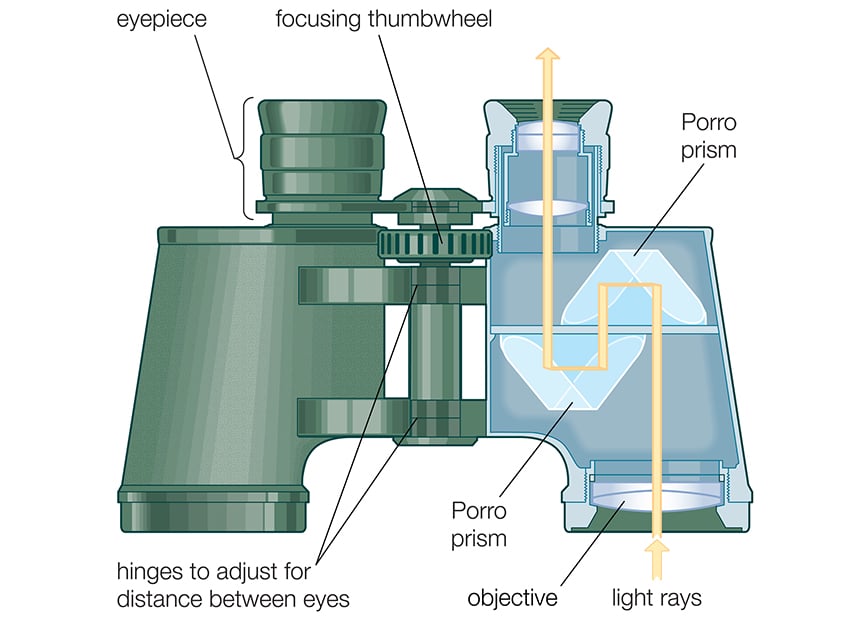
Binoculars employ the same science of optics. They have 2 convex lenses Trusted Source Image Formation by Lenses | Physics Lenses are found in a huge array of optical instruments, ranging from a simple magnifying glass to the eye to a camera’s zoom lens. In this section, we will use the law of refraction to explore the properties of lenses and how they form images. courses.lumenlearning.com , placed one in front of the other. The first one catches light rays from your target object and creates a focused image a short distance behind the second lens. The first lens is called the objective lens because it is closest to your target object or subject.
The second lens picks up the image and magnifies it the same way a glass magnifies an image on paper. The second lens is called the eyepiece. The eyepiece and the objective lens together make a telescope. Binoculars are in essence, 2 telescopes placed side by side for each eye.
They also feature prisms that rotate an image through 180 degrees. This prevents the images from appearing upside down when you look at them through the eyepiece. At least every binocular has a pair of prisms either in a back-to-back arrangement (roof prisms) or in a 90 degrees arrangement porro prisms.
So every pair of binoculars has a total of 4 prisms; 2 in each telescope. Prisms are the main reason why Binoculars are heavy and chunky in the middle.
Here is some more detailed information on how binoculars work.
Magnification
Binoculars have a wide range of magnification. Standard binoculars have anything between 4x and 10x. You will hardly see a common all-purpose pair of binoculars with more than 12x magnification.
As it is with most optical devices, the higher the level of magnification, the larger the binoculars. A pair of binoculars with a 12x magnification will be larger than one with a 4x magnification. Therefore, if you are looking for binoculars that you can easily move around with you have to go with a lower magnification level.
Lens and Prisms
Binoculars come with different lens sizes. The compact models made for easy portability come with lenses as small as 25mm. the full-size ones can have lenses as large as 40-50mm. There are a few specialty binos that have lenses as large as 100mm. These however, are impractical for day viewing. They are mostly meant for astronomy. A prime example is the Celestron SkyMaster 20X80 Astro Binoculars. It is a popular choice for entry-level astronomers because of its powerful magnification and its durable, rugged construction.
As for prisms, there are 3 main types commonly found in binos; Galilean, roof and porro prisms. Porro prisms provide more depth and clarity because of their Z-orientation. Their only downside is that they are fragile and always need a realignment.
Roof prisms are common in compact binoculars because they reduce light transmission to improve magnification. Binos with roof prisms are highly preferred for waterproofing, streamlined design, and durability.
The Galilean prisms are a primitive kind. They are mostly used in kids’ binoculars and opera glasses because they have a poor field of view and low magnification.
Field of View
Generally, when magnification increases, field of view decreases. Binoculars don’t really have high magnification levels, for this reason, they shine when it comes to field of view.
High-end binoculars have a field of view ranging anywhere between 300ft and 450ft per 1000yards.
When you’re having the high power binoculars vs. spotting scope debate, the choice comes down the outdoor activity you need the device for. There are a couple of things you must consider before making your choice like; the amount of magnification power you will need, weight and size, the type of activity you will be using the device for.
This comparison will help you know what each of these devices does best. By comparing the features you won’t have any difficulty making a choice when stuck between a 20x binoculars and a spotting scope.
When it comes to a convenient size and weight, binoculars are the winner. They are designed to be portable and you can wear them around your neck for added convenience. There are ultra-compact models that you can easily pocket. Though there are larger and heavier binos that weigh the same as some spotters, majority of the binos out there are easier to carry and handle compared to spotting scopes.
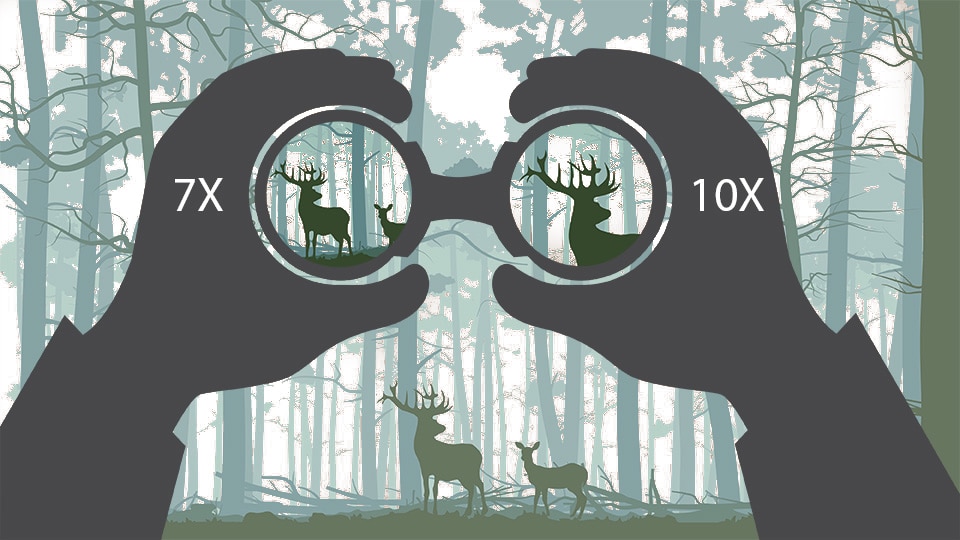
Spotting scopes shine when it comes to magnification power. Some of them have magnification levels as high as 60x. Binoculars on the other hand, are on the lower range in terms of magnification, with the highest coming in at 12x.
Since spotting scopes are designed to work during the day, viewing objects that are too far away can be a challenge as the image will get affect by the atmospheric conditions like dust particles, air currents, and heat waves.
There are specialty binoculars, especially the ones designed for astronomy, that have powerful magnifications between 15x to 100x. You can only use them with a tripod.
The bottom line is a standard spotting scope will be more powerful than a standard pair of binoculars.
The bigger the objective lens the better the image quality. The size of your device’s objective lens is the second number that comes after the x in the specifications. For instance, a 15-60x 60mm is a spotting scope or binoculars with a 15-60x zoom and a 70mm objective lens.
Also, keep in mind that bigger is not always better when it comes to lenses. Quality matters more than size. Spotters come with different size objective lenses ranging from 45mm to 100mm. Binoculars, on the other hand, have objective lenses ranging from 25mm to 42mm.
Your typical binoculars will have smaller objective lenses than a typical spotting scope. Therefore Spotting scopes win when it comes to objective lenses.
With a bigger field of view, you can see a lot through the eyepiece of your device. A bigger field of view means you can see more. Magnification affects field of view. The higher the magnification the smaller the field of view.
Since spotting scopes have higher magnification levels compared to binoculars, they have a smaller field of view. Binoculars will allow you take in much more of your view with their ultra-wide angle design eyepieces. You will also be able to follow moving targets with ease.
Most binoculars are hand-held. The more you zoom in on an image the more your hand movements increase. It’s almost impossible to use a pair of binoculars at a high magnification of about 10x to 12x without a stand or tripod. You will end up with shaky low-quality images.
This is the main reason why standard binos with a magnification power higher than 12x are rare. Even the specialty ones that have a 100x magnification power must be used with a stable base.
With a stable base, both binos and spotters can give you a steady image.
This is the most minimum distance that an object can be away from you for your optic to be able to focus on it well. Both binos and spotters are made to view objects from a distance, but there are some instances when you might need to focus on something that is only 5ft away from you.
A device with a lower magnification power will have the closest available focal point. Since many all-purpose binoculars have a lower magnification level than spotting scopes, they have nearer close focal points.
This is another factor that distinguishes the 2 devices from each other. Binoculars are straight and all you have to do is point them you want to look. You can get binoculars with angled observation eyepieces but they are very rare.
Angled spotting scopes on the other hand are a common thing. Choosing an angled or straight spotter is a matter of personal preference, though an angled one is probably a tad easier to use. Imagine looking through a scope mounted on a tripod, for the angled one you wouldn’t have to bend your entire body.
It’s hard to compare the costs of spotting scopes and binos because they are completely different in so many ways. You can pay a pretty penny for either or get a really good low-budget deal for either.
Generally, mid-range binoculars tend to be more affordable compared to mid-range spotting scopes. This is mainly because of the less costs involved with smaller lenses and less magnification power.
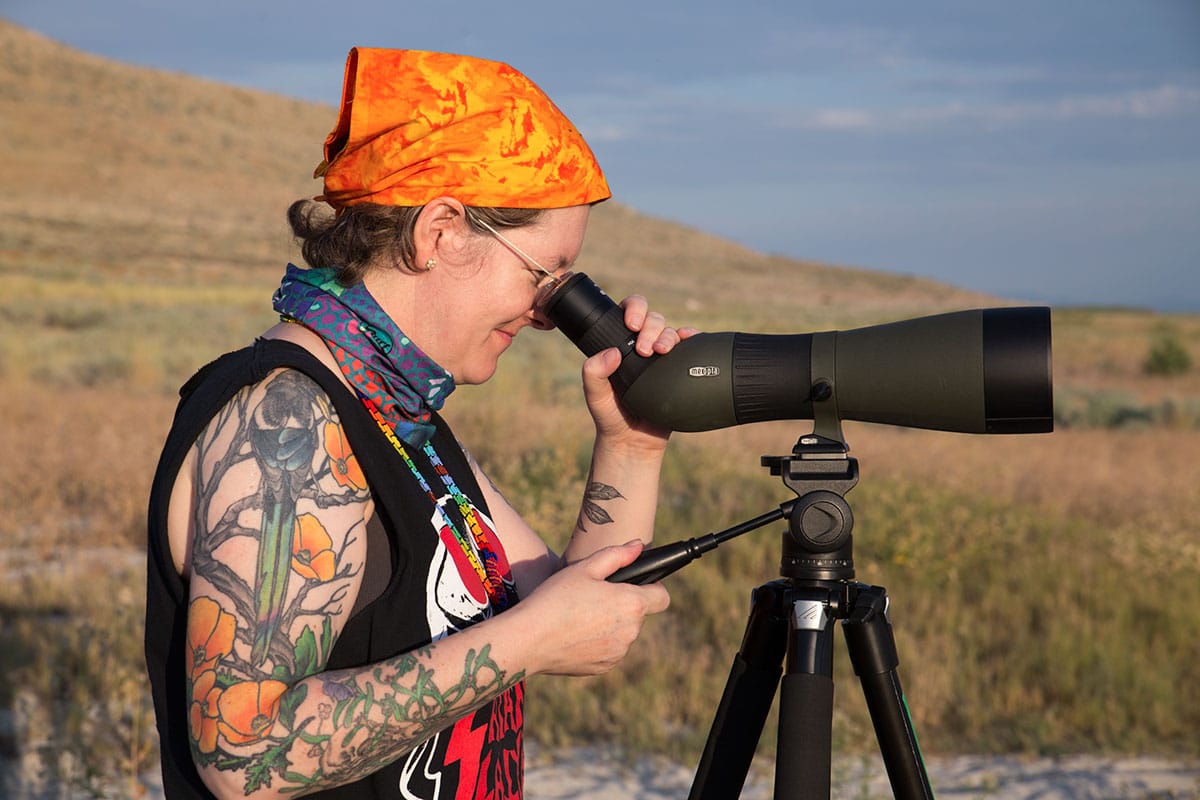
As an outdoors enthusiast, you are likely to be confused on whether to get a spotting scope or binoculars for hunting or astronomy. Here is what you should get a spotting scope for:
Surveillance – if you want to monitor something or someone from a far distance, a spotting scope mounted on a tripod is the best tool for the job.
Sniping – Binoculars vs. spotting scope snipers? Definitely spotting scope. A spotting scope combine with a long-range sniper will help you acquire your target and determine range.
Target shooting and archery – many people wonder whether to pick a spotting scope or binoculars for target shooting. A spotting scope is a safe bet provided it is set up in a field position on a stand or tripod.
Long-range bird watching – Bird watchers prefer spotters for high-quality images from a long distance.
Hunting – Hunters looking to spot and hit targets in the long range prefer to use spotting scopes. It increases their chances of hitting their target because they don’t get to alert or interfere with their environment.
Amateur astronomy – A telescope is the best instrument for astronomy but a solid 60x spotting scope is good enough for amateur astronomy. It will give you a great view of celestial bodies like Jupiter and the moon.
Photography – If you are a passionate photographer and would like to capture some dangerous species that you cannot risk to get closer to, a spotting scope should be your go-to instrument. All you have to do is combine it with your camera or phone and you get a powerful telescopic lens.
Moreover, spotting scopes are the best if you intend to stay stationary and get detailed images from a long range because they are not easily portable.
Binoculars, just like spotting scopes, have tons of uses. Their compact, portable and easy-to-use build makes them suitable for various applications. They are the best when you need something that doesn’t weigh you down and can easily fit in your luggage.
They are also perfect for viewing objects that aren’t too far because they have a close focal point. Plus their less than 12x magnification isn’t the best for very long distance viewing.
Another reason why you should pick a 15x binoculars over a spotting scope is because it has a wider field of view. A wide field of view is important for watching moving targets. They are therefore perfect for sporting events, hunting, nature and wildlife watching as long as your target isn’t too far.
Also binos are more rugged than spotters. This makes them the most ideal for rough environments and harsh weather conditions. Although spotters have weather-resistant and impact resistant features, binos are more durable all-around.
Lastly, Binos are your best option if you have a low-budget. You can get a high-end pair of binos with powerful magnification at the same reasonable price point of an entry-level spotting scope.
With all the in-depth information about spotting scopes and binoculars above, you shouldn’t have trouble taking a side in the spotting scope vs. binoculars debate. As much as they share so much in common, their features make them suitable for different applications. If you don’t want to dig deep into your pockets, binos are your best bet because you can get the best zoom binoculars at the same price of an entry-level spotting scope.
Some of the main aspects you should consider when making a choice between a spotting scope and binoculars include; magnification power, how far you will trek in your adventure, how often you will move, and whether you must be able to scan quickly. You also need to establish the purpose for which you need the device to be able to narrow down your options considerably. A hunter and an astronomer cannot be looking for a similar device.